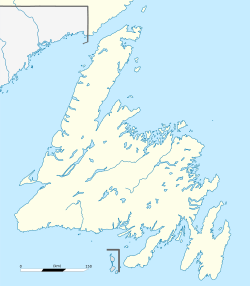Long Island (Placentia Bay, Newfoundland and Labrador) facts for kids
| Geography | |
|---|---|
| Location | Placentia Bay |
| Coordinates | 47°34′00″N 54°05′30″W / 47.56667°N 54.09167°W |
| Length | 25 km (15.5 mi) |
| Width | 3 km (1.9 mi)at its widest portion. |
| Administration | |
|
Canada
|
|
| Additional information | |
| Time zone |
|
| • Summer (DST) |
|
Long Island is a long, thin island found inside Placentia Bay in Newfoundland and Labrador, Canada. It stretches about 24 kilometres from north to south. At its widest point, the island is just over 3 kilometres across. Long Island is one of the main islands in Placentia Bay, along with Merasheen Island and Red Island. It is located about 22 kilometres northwest of Argentia. A channel separates Long Island from Merasheen Island to its west. This channel is 24 kilometres long and narrows to just 2.12 kilometres at its closest point. Red Island is about 10 kilometres southwest of Long Island.
Exploring Long Island's Geography
Today, Long Island is mostly uninhabited. Only a few visitors come to the areas where communities used to be. The island once had several small towns. These included Peaches Cove, Spencers Cove, Haystack, Kingwell, Port Royal (which was first called Mussell Harbour), Harbour Buffett, and Coffin Cove. All these communities have since been resettled, meaning people moved away.
The name "Long Island" is quite common in Newfoundland and Labrador. There are at least 19 other islands in the province with the same name! For the people who lived on Long Island, fishing was the most important part of their economy.
The island's many coves and inlets were named by early English and Irish settlers. You can find names like Collett Cove, Hay Cove, and Hennessey Cove. There are also places like Kearney Head, Dicks Island, and Isaac Island. Some smaller, uninhabited islands nearby also have interesting names. These include Bread and Cheese Islands to the north, Great Seal Island and Iron Island to the south, Dog Island off the eastern coast, and Barren Island to the west.
A Look at Long Island's History
The biggest settlement on Long Island was Harbour Buffett. It was located at the southern end of the island. This town was the main place for people to get supplies and where fish merchants did business. There were no roads on Long Island. Most communities were connected by walking paths. For example, the towns on the northern end, like Spencers Cove, Haystack, and Peaches Cove, were separated from Harbour Buffett by a 16-kilometre path through the wild landscape.
In the 1800s and 1900s, important merchants in Harbour Buffett included James Chambers, Thomas Hann, and Freeman Wareham. Alberto Wareham ran a business from Spencers Cove. The people of Spencers Cove and Harbour Buffett were among the last to move under the resettlement program. This program, which helped people move from small, isolated communities to larger towns, took place in the 1960s and 1970s.
By the 1970s, everyone on Long Island had moved to towns and villages on the mainland around Placentia Bay. After this, the island went back to being mainly a base for summer fishing.


